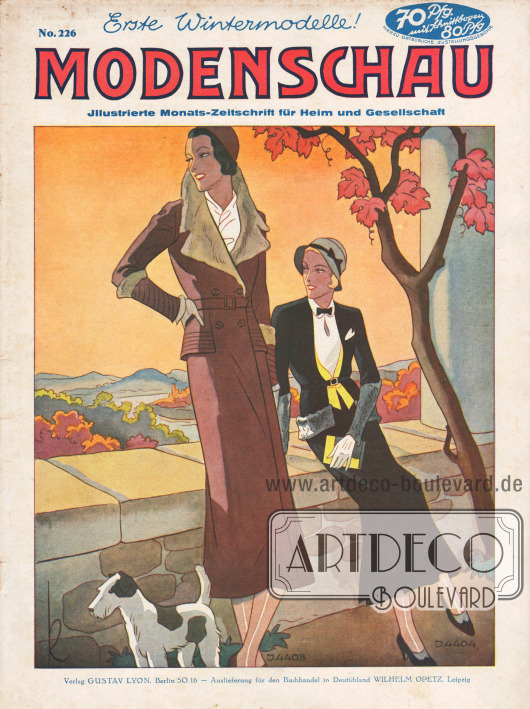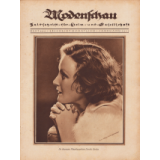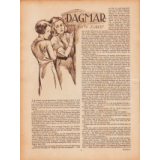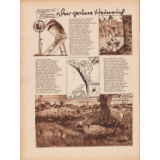|
|
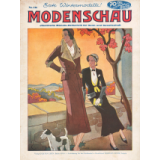
|
Front page or cover of the German fashion magazine Modenschau (subtitle: Illustrated monthly magazine for home and society) no. 226 from October 1931.
First winter models!
J 4403. Elegant coat made of reddish wool fabric. Lap and cuffs are tucked. Fabric usage: about 3 m, 130 cm wide. Pattern size 44 and 48. Price RM. 1.—.
J 4404. Brisk costume in black cloth with belted jacket showing gray astrakhan trim. — Fabric usage: about 3.30 m, 130 cm wide, 0.50 m trim fabric, 100 cm wide. Pattern size 42 and 46. Price RM. 1.—.
Publishing company Gustav Lyon, Berlin SO 16 – Delivery for the book trade in Germany Wilhelm Opetz, Leipzig.
Title illustration/title drawing: "k" (Ernst Ludwig Kretschmann, 1897-1941).
|
|
|

|
Article:
N. N., The Language as a Reflection of Times;
Publishing House Gustav Lyon, Graphological Department, Character and Handwriting.
[N. N., The Language as a Reflection of Times.]
We are living in incredibly fast-moving times. Inventions are rushing in. What is perceived as a great sensation today will be a thing of the past tomorrow. For example, we recently followed Professor Piccard's ascent into the stratosphere with great excitement, and how relaxed we will be when the third or fourth attempt is made in this field. Our language gives us a clear indication of the pace of this hasty development. If we take a systematic look at the new buzzwords that have entered our everyday language and become commonplace since the World War alone, even the most phlegmatic mind will feel a jolt and hardly believe that this influx of new word formations is possible. The broad field of technical inventions alone provides a series of new word formations that can hardly be overlooked. Before the war, who knew anything about the "outboard motor", which, as we know, can be attached to the outside of rowing boats to transform a simple boat into a motorboat without difficulty? Before the war, who had any idea about "Bildfunk" ["wireless photography"], the transmission of photography by wireless means? The "Tonfilm" ["talkie" or "sound film", note by M. K.] was just as unknown to the general public at that time as the "detector", the "antenna" and the "loudspeaker". "Television" was also completely unknown at the time. The range of musical instruments was enriched by the "singing saw", the "saxophone" and many others. The "traffic tower" was created to regulate the jumble of cars, streetcars, bicycles and motorcycles. The icebox was replaced by the much more effective apparatus of the "Frigidaire" [electric refrigerator], and the range of seating furniture was significantly enriched by "steel furniture" of all kinds. The ban on alcohol in America gave rise to the term "Prohibition", and nutritional science delighted us with the "Gerson diet". The broad field of advertising was scientifically enriched by "market analysis", the exact study of supply and demand on the goods market, and the theaters hoped for great success by abandoning historical and psychological drama in order to devote themselves entirely to the problem of the present. They then marched under the flag of "contemporary theater". The languages of all cultural nations adopted the slogan "Pan-Europe" under the idea of leading the peoples of Europe out of their economic and political turmoil towards a unified state.
Before the war, who knew what "atonal music" meant, a compositional method that is not bound to a fixed key. From the wide realm of music, "ether wave music" should also be mentioned, which, as is well known, owes its origin to radio-electric waves. It is also worth remembering the "Bubikopf" ["bobbed hair" or just "bob"], the female hairstyle, as a similar one before the war was called "Tituskopf" ["Titus head"]; "raw food" as a revolutionary transformation of nutrition; "front generation" as the name of those people who made up the majority of the army at the outbreak of the war; "Vermaennlichung" ["masculinization"], as the cultural and psychological transformation of modern women, who put all their ambition into striving to match men in the fields of sport, all professions and their entire lifestyle; this cultural trend of masculinization also brought to light numerous other new trends. For example, the "men's cut", also known as the "Eton crop", the "beret" introduced by men and adopted by women, etc.
The development of financial organization brought us the two expressions "old property" and "revaluation". The former refers to securities that the holder already owned before the end of the war, and by "revaluation" we mean partial compensation for devalued paper mark claims.
The "Beamten-Abbau" ["downsizing of civil servants"], i.e. the dismissal of superfluous staff in the offices, had a depressing effect.
The area of career choice was expanded by a scientifically trained system of "career guidance", and "standardization" was introduced to make it easier to procure replacements for used machine parts.
This list could be extended indefinitely, indeed, a thick encyclopedia would have to be produced if a book were to be published explaining all the new expressions that the last twenty years have brought us.
|
|
P. 3 |
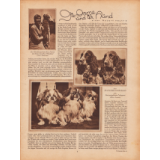
|
Article:
Hecht, Robert, The Lady and Her Dog (by Robert Hecht, unknown author).
Matching the article are three photographic images. The captions read "Film actress Kay Francis [1905-1968] with her Russian wolfhound [sighthound or greyhound, note by M. K.]," "Above: Two magnificent Norfolk Spaniels," and "Left: Three prize-winning Pekingese."
Photos: Paramount; Kutschuk.
[Page] 3
|
|
P. 4 |

|
J 4536. Elegant visiting dress in black marocain with white jagged collar folded in at the armpits. Left agraffe with hanging trim. Fabric usage: about 4.15 m, 1 m trim fabric, each 100 cm wide. Pattern size 44. Price RM. 1.—.
J 4537. Elegant dress in colored crepe mongole. Very dressy is the gathered front part. Skirt with front pleat group. Leather belt in darker tone. Fabric usage: about 4.50 m, 100 cm wide. Pattern size 44. Price RM. 1.—.
J 4538. Elegant afternoon dress in navy blue crepe de chine. The moderately wide bell skirt has a round-cut peplum at the front. Pleated front. The sleeves are slit in the lower part. Fabric usage: about 3.20 m, 100 cm wide. Pattern size 44. Price RM. 1.—.
Photos: Studio Joel Feder, New York City (biographical data unknown).
[Page] 4
|
|
P. 5 |
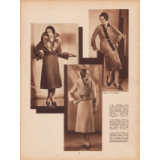
|
J 4539. Youthful coat of figured wool fabric. The lapels are widened by underworked trimmings. Dark suede belt. Raccoon collar. — Fabric usage: about 3.60 m, 130 cm wide. Pattern size 44. Price RM. 1.—.
J 4540. Elegant coat of nubby wool fabric, wide overlapping in front. Collar and sleeve trimmings are of light astrakhan. Fabric usage: about 3.20 m, 130 cm wide. Pattern size 44. Price RM. 1.—.
J 4541. Smart costume in medium-colored cloth. Buttoned cuffs complement the sleeves. Broad lapel on the left, joined by the seal stripe. Fabric usage: about 2.80 m, 130 cm wide. Pattern size 44. Price RM. 1.—.
Photos: Studio Joel Feder, New York City (biographical data unknown).
[Page] 5
|
|
P. 6 |
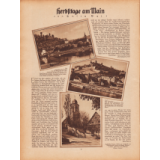
|
Article:
Sell, Anita, Fall Days Along the Main River (by Anita Sell, unknown authoress).
Three photographs are attached to the article. The captions read "The ancestral castle of the Counts of Wertheim has been in ruins since the Thirty Years' War. The successors of the builders, the Princes Loewenstein-Wertheim-Freudenberg, now reside in a new castle in the small town of Wertheim", " High above Wuerzburg towers the Marienberg fortress, once the residence of the prince-bishops and a fortress of protection against the rising will to power of the citizens of Wuerzburg" as well as "Picturesque staircases lead to the local church of Winterhausen, an idyllic wine village between Wuerzburg and Kitzingen."
Photos: Kester (Philipp Kester, 1873-1958).
[Page] 6
|
|
P. 7 |
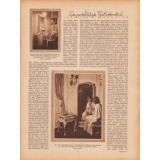
|
Article:
Wedekind, Anna P., The Unveiled Toilet Table (by Anna P. Wedekind-Pariselle, biographical data unknown).
There are two photographs accompanying the article. The captions read "Everything here is designed for practicality—but there is still a great deal of grace in the lines of this toilet table!" and "A very practical solution: the toilet table and mirror are separate, so the table can be placed anywhere within easy reach."
Photos: Matzdorff (Alice Matzdorff, 1877-1932); Kiesel.
[Page] 7
|



